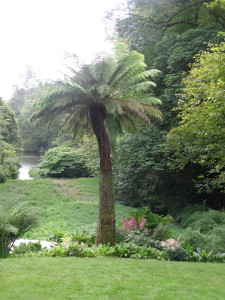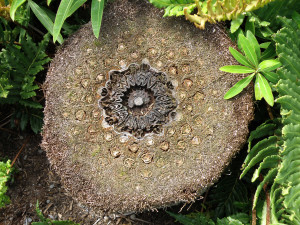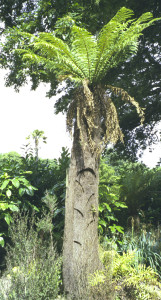As one of the most popular examples of this fascinating and fashionable group of plants, it is seen more and more available for sale. Appearing like a fern on top of a short trunk its slow rate of growth is reflected in its relatively high price. There is a lot of confusion over its hardiness with some saying it is only hardy in the mildest areas of the UK while others, including Kew, say its foliage is hardy down to -2°C but the plant itself is hardy down to -10°C. Part of this may be expectation as it is only found in the tropical regions of the southern hemisphere, but may also reflect the location a particular plant has been collected from as it is found at up to 1000m above sea level where plants would be expected to be more cold tolerant. With that in mind, and considering the cost of the plants it may be as well to adopt a cautious approach as frost below -10°C are not unknown in most parts of the UK and provide some frost protection. This is commonly achieved by wrapping the plants in horticultural fleece or straw secured with chicken wire.
Dicksonia Antarctica Labill. Thrives in cool damp situations: given time and the right conditions it can achieve a 3 metre trunk and 2.5 metre long fronds. To do well it needs plenty of water and given enough water it is quite tolerant of exposure to sun. As you might expect from its natural habitat it does best in a humus rich acid loam but it is quite capable of growing in most soils, even poorly drained ones. There slow rate of grow makes them very suitable a pot plants, which allows them to be moved indoors in cold weather, but they do resent being pot bound. The strange structure of the trunks means the top of a tree fern can be cut off and will regrow if being planted; but the lower potion will not as it is composed of dead material.
The extant species of tree ferns are a remnant of a far greater group which helped lay
down the coal seams mined today. They do not form a taxonomic group as such and the term only refers to any tree with a wood like trunk raising the fronds off the ground. In UK gardens Dicksonia Antarctica Labill.is the species most commonly found and as originally described by Jacques J.H. de Labillardière. M. Labillardière published his description in the second volume of his to volume Novae Hollandiae Plantarum Specimen, which was the first flora published of Australia (or New Holland as it was then known). The journey from Australia to the floras publication in 1806 was anything but straight forward. Labillardière was a naturalist attached to the expedition the French sent out to find what had happened to the expedition lead by Jean-François de Galaup, comte de Lapérouse. They failed to find the lost expedition but did explore parts of Australia, New Zealand and surrounding islands. While they were away The French Revolutionary wars were causing upheaval in Europe and on reaching Java the expeditions scientific collections were seized by the British. It was only by appealing through influential British contacts that he was able to secure their return and so publish their descriptions.
References:
http://www.kew.org/plants-fungi/Dicksonia-antarctica.htm
Encyclopaedia of Ferns by David L. Jones
Hardy Garden Plants (3rd Edition) by Graham Stuart Thomas
‘The International Plant Names Index (2012). Published on the Internet http://www.ipni.org [accessed 24 June 2013]
Novae Hollandiae Plantarum Specimen by Jacques J.H. de Labillardière






